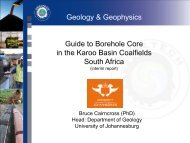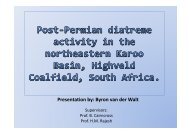coaltech upper olifants river catchment wetland inventory ...
coaltech upper olifants river catchment wetland inventory ...
coaltech upper olifants river catchment wetland inventory ...
You also want an ePaper? Increase the reach of your titles
YUMPU automatically turns print PDFs into web optimized ePapers that Google loves.
3.4.3 Pans<br />
Pans are sometimes difficult to define (Allan et al 1995, Morant 1983). Endorheic pans are<br />
typically circular to oval shallow depressions without an outflow. Pans are seldom more than<br />
three meters deep, although systems up to 20m deep have been defined as pans. Some<br />
systems in Mpumalanga that are large, deep and permanently wet can be defined either as<br />
pans or as lakes. In addition, pans have been viewed as a lake type in the past (Allan et al<br />
1995).<br />
The classification of pans in South Africa has various problems and is mostly based on the<br />
function of the classification system. A classification system proposed by Noble and Hemens<br />
in 1978 classified pans on the physical characteristics of the pans, as well as the fauna and<br />
flora species composition. The pans were classified as, salt, temporary, grass, sedge, reed<br />
and semi-permanent pans. Other classification systems also focussed on the duration of<br />
inundation (Allan et al 1995, Geldenhuys 1982). Pans in the UORC cannot be sub-divided<br />
into different <strong>wetland</strong> types, since too little information of pans in the <strong>catchment</strong> is currently<br />
available to attempt this.<br />
Pans are normally distributed in the dry part of the country, but a number of pans also occur<br />
in the wetter portions of the country, including the UORC. Pans are also distributed across<br />
various vegetation biomes, including grassland, the vegetation biome present in the UORC.<br />
The distribution of pans across the world is generally affected by four abiotic factors. These<br />
factors are bedrock, drainage, slope and climate. Climatic conditions normally associated<br />
with the formation of pans are low mean annual rainfall (lower than 500mm) and high mean<br />
annual evaporation loss (higher than 1 000mm). A good example of an exception to this rule<br />
is the pans in the UORC, an area with annual rainfall of approximately 700mm (Allan et al<br />
1995).<br />
The formation of pans is complex and can be influenced by climate, geology, surfaces,<br />
disturbance by animals, lack of integrated drainage systems and wind. The collection of<br />
water in the pans contributes to the enlargement of the pans. When pans dry out in the dry<br />
season the area is bare of vegetation. The loss of sediment takes place through the action of<br />
wind. The pans therefore, become deeper and larger and the round shape of the pans is<br />
caused by the swirling action of winds. Animals trample the edges of the pans thereby<br />
loosening the soil and carrying mud away from the pan (Allan et al 1995, Goudie & Thomas<br />
1985).<br />
Wetland Database for UORC - 32 -




